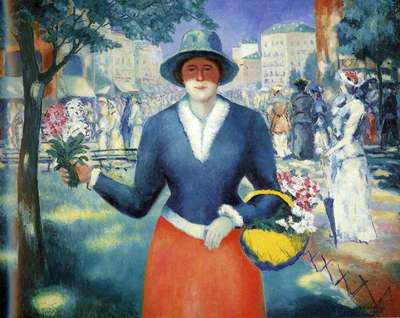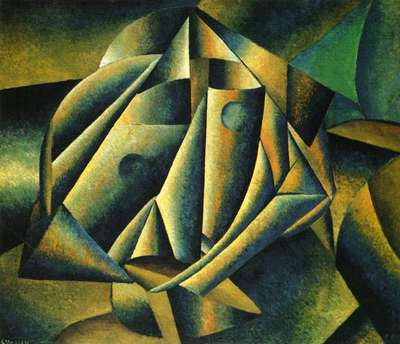Kazimir Malevich was a russian painter, art theorist [theoretician] and head of the avant-garde Suprematism movement. He was born in Kiev Governorate, but moved in 1904 to Moscow. He studied at the Moscow School of Painting, Sculpture and Architecture and got in touch with some of his first influences in art. He was introduced to Larionov in 1906. Four years later Malevich was part of a collective art exhibition with Larionov and Gancharova. It was the first time that he takes part of the Jack of Diamonds show.
It is known that Malevich, more than any other artist, was the one who first used the cubist geometry as a start point to an absolute geometric abstraction. During the years of 1911 to 1913 he experimented different aspects and properties of the cubism and futurism movements. However, his biggest question was related to the reduction of the subject matter. As Malevich itself describes: “…in the year 1913, in my desperate attempt to free art from the burden of the object, I took refuge in the square form and exhibited a picture which consisted of nothing more than a black square on a white field”. This was the first step towards the Suprematism movement. “The supremacy of pure feeling in creative art.” as stated by Malevich in his book “The Non Objective World”.
Amongst his contemporary artists that had being part of the abstractionism movement, Malevich was the unique to use the ultimate geometric simplification in such scale.
His contribution to the twentieth century art and academies was enormous. His purely geometric abstraction served as inspiration for many future generations, such as the russian Constructivists, to El Lissitzky, to the Bauhaus theories, to the international design of modern architecture and some decades later we can investigate how much of it had possibly influenced the history of the early computer art.
After some detailed analysis on works of the early computer art works we found such influence in the work of Michael Noll as well as in the work of Kenneth Knowlton & Lillian Schwartz, although it has never before been directly related to Malevich canvases.
The Michael Noll’s piece “3-Dimensional Projection of a Rotating 4-Dimensional Hypercube” (1962) has the simplicity of the abstract thoughts of Malevich. Firstly for its 3D shaping, that can be analyzed as encouraged the serious and deep three dimensional studies made by Malevich during the years of 1915 to 1923. Besides that, Michael Noll’s 3D projection can be inspired by the phase of “aviation passion” when Malevich’s expresses on his canvases the purest sensation of flying and portrays the feelings of movement (1913-1918). The diagonals and three dimensions are now literally moving and celebrating the new technologies abilities of expression.
The Kenneth Knowlton & Lillian Schwartz work “[”Pixillation":http://dada.compart-bremen.de/node/2656]" (1963) programmed in BELFLIX is aesthetically an evolution of the black squares to an reverse contrast of black background with numerous white squared in movement and circunscrits. The complexity of such piece is obvious if compared to the first phase of Malevich. Nevertheless it can be related to it as a start point of the supremacy of the geometrical forms. Such as they would not exhibit such movement concepts trying organics shapes, for instance. The dynamics of such work, also correlated to movement, as it is an animation, might be related to the “complication” phase of Malevich, where he experiments creating tension between two or several instruments. The optical illusions resulting from such animation can also be related to the optical art movement, which certainly had been influenced by Malevich first steps towards geometric and simplification of forms and colours
The abstraction of coding, once again should be mentioned as part of a process where the mimesis of the real can not be assumed as an immediate act as it was possible before. Even if the final product ends up being a naturalist portrait, the process of composing it will always have a mediation of a written code and an interpreter, a computer, to deliver it. The mandatory abstract act of coding would constantly invite the artist-programmer to a deep dive into the beauty of the mathematical language as universal as Malevich’s canvases was intended to be.









